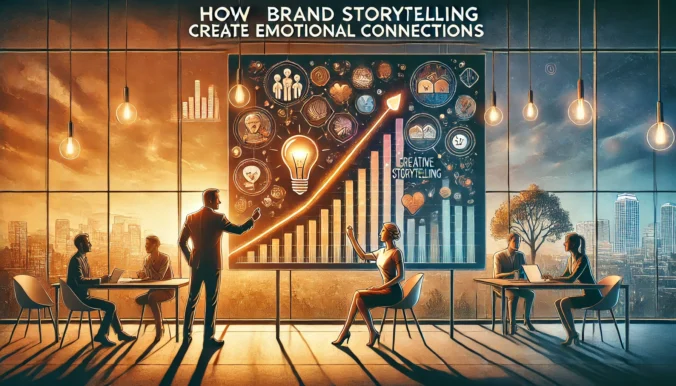Brands do not just sell any products or services in the saturated marketplace; rather, brands sell stories. Brand storytelling has evolved as an active approach for which it can offer emotional connectivities to customers.
By developing powerful narratives, businesses have been able to create uniqueness, establish trust, and eventually attain loyal adherence. Here in this article, we would try to find out the effect of storytelling strategies of any brand on its excellence and proffer tips useful for a story to help your target audience resonate.
What is Brand Storytelling?
Brand storytelling is an art that tells stories for communicating a brand’s values, mission, and purpose. It is much about not being confined by just the feature-function-benefit trilogy in forging deeper, more personal contact with your audience. It makes your brand memorable, through which this approach harnesses the power of emotions, memories, and aspirations.
For instance, Nike and Apple, these two iconic brands, have mastered this art of storytelling in marketing. They do not sell shoes or gadgets; they sell a lifestyle, a belief system, and a community.
Why is Emotional Branding through Stories Important?
Humans are wired for stories. Neuroscience reveals that storytelling activates various parts of the brain, which in turn enhances memorability and emotional connection. When your brand story is resonating on an emotional level, customers are most likely to:
1. Trust your brand
2. Stay loyal over time
3. Recommend your products or services to others
A well-told story builds feelings of belonging and shared purpose. Through authentic storytelling for brands, businesses can create an affinity with customers that sometimes isn’t possible through traditional ads.
Elements of a Compelling Brand Story
To ensure your brand story is going to resonate, consider the inclusion of these elements:
1. Authenticity: Your narrative should be congruent with your brand’s values and ethos. Consumers can spot a lack of authenticity from a mile away, and it only serves to destroy trust.
2. Relatability: The struggle or achievement should be relevant to the aspirations or struggles of your target audience, making it personal and poignant.
3. Conflict and Resolution: Behind every great story is an underpinning conflict. Bring out how your brand creates solutions for its customers.
4. Emotion: Stir a sense of emotion within your audience. Joy, hope, or even nostalgia-the aftertaste of a feeling is what will make it memorable.
5. Consistency: Your story should be very consistent across platforms: websites, social media, offline touchpoints.
Brand Storytelling Strategies to Drive Emotional Engagement
In today’s competitive landscape, brands must go beyond selling products—they need to connect emotionally with their audience. Brand storytelling is a powerful way to build trust, foster loyalty, and create memorable experiences.
By weaving compelling narratives, businesses can inspire customers and transform them into passionate advocates for their brand.
1. Know Your Audience
Knowing your audience’s needs, desires, and pain points is key to crafting your narrative in their voice. Use tools such as customer personas and social listening for insights.
2. Core Value Brand Narrative Creation
The narrative is what makes your brand special. For instance, a sustainable clothing brand could tell stories of its ethical sourcing practices and how it is committed to reducing waste.
3. Apply Visual Storytelling Techniques to Businesses
Give your story a visual form with images, videos, and infographics. A photo-sharing platform like Instagram is great for visual storytelling, much like YouTube for video blogging.
4. Incorporate User-Generated Content
Share true stories of customers. In addition, testimonials, reviews, and social media conversations can help in adding realism to your brand story.
5. Collaborate with Influencers
Partner with influencers who gel well with your brand and values. Their endorsement is going to add credibility, thereby increasing your reach.
6. Use Data to Validate Your Story
While emotions make people decide, data creates trust. Add in statistics or metrics that support your claims.
Storytelling in Marketing: Case Studies
Let’s take a look at some brand storytelling examples to understand the effect of storytelling on branding:
1. Coca-Cola: Sharing Happiness
Coca-Cola adverts talk about moments of joy and togetherness. Their storytelling is based upon emotions which are universal, making their brand universally appealing.
2. Airbnb: Belong Anywhere
Airbnb ensures that the stories of hosts and travelers are told in a manner that can evoke a sense of belonging and attachment that their site does. This helps them personify their brand, alluring to both guest and host alike.
3. Dove: Real Beauty
The Dove Real Beauty campaign redefined beauty through actual stories of women. The emotional branding through stories connected on an extremely deep level with its audience.
How to Tell a Brand Story Effectively
1. Lead with a Mission Statement: Identify what your brand is for and state it out loud.
2. Create a Character: Whether it is a customer, employee, or the brand itself, having a relatable protagonist makes the story appealing.
3. Show, Don’t Tell: The use of bright descriptions and visuals engages the audience.
4. End with a Call-to-Action: Encourage your audience to engage with your brand by purchasing a product, sharing content, or joining a community.
How Storytelling for Customer Engagement Translates to ROI
Storytelling is not a feel-good but tangible outcome. Brands using storytelling techniques have higher engagement, retain more customers, and boast stronger brand identities. Well-told stories can do the following:
1. Improve your brand’s social media performance
2. Enhance PR for brand awareness
3. Drive more traffic to your website
For instance, a branding agency in Canada might use success stories to tell its tale of success, thereby gaining more clients by commanding credibility.
Common Pitfalls to Avoid
While storytelling is powerful, here’s what not to do:
1. Overcomplicating the Narrative: Keep it simple and focused.
2. Inconsistency: Mixed messages will surely confuse your audience.
3.
\Ignoring Data: Back your story up with facts to maintain credibility.
Conclusion: The Power of Storytelling in Marketing
Brand storytelling is more than a trend; it is a necessity in today’s competitive landscape. You’ll have the ability to differentiate, build customer loyalty, and drive meaningful engagement by crafting authentic narratives that strike at the emotional core.
Be it in social media marketing services or re-imagining your brand the addition of storytelling will elevate all your branding efforts. The best stories don’t sell products; they leave an impression that may last.
Start telling your brand story today and watch how it will change your relationship with your audience. At Tribe and Tales, we believe in helping brands like yours find their unique stories and giving them life through strategic PR, visual branding, and digital marketing services. Let’s tell your story together.

A Marketing Communications and Advertising professional, I have worked across some of the biggest agency conglomerates like Publicis and WPP, handling the Communications mandate for brands like Shaadi.com, Reliance Fresh, Tanishq, Netflix and more.

Leave a Reply